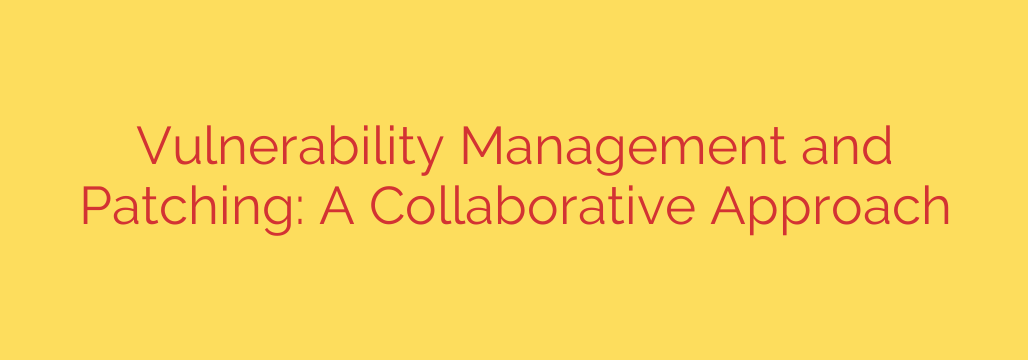
Uniting Security and IT: A Modern Guide to Vulnerability and Patch Management
The relentless pace of new security vulnerabilities can feel overwhelming. For many organizations, the process of identifying threats and deploying patches is a fractured, inefficient cycle that leaves critical systems exposed for far too long. The traditional approach—where a security team finds a flaw and simply “throws it over the wall” to the IT operations team to fix—is no longer sustainable.
To build a truly resilient cybersecurity posture, organizations must move beyond these operational silos. The future of effective security lies in a collaborative, unified approach to vulnerability and patch management, where Security and IT work as a single, integrated team.
The Problem with a Disconnected Approach
When security and IT operations work in separate silos, friction is inevitable. Security teams are focused on identifying and reporting every potential risk, often generating massive lists of vulnerabilities. IT teams, on the other hand, are judged on system uptime, stability, and performance. They must balance the urgent need for patching with planned maintenance windows and the risk that a patch could break a critical application.
This disconnect leads to several critical problems:
- Delayed Remediation: Without shared priorities, critical vulnerabilities can linger for weeks or even months, creating a wide-open window for attackers.
- Lack of Context: Security reports may flag a vulnerability as “critical” based on its technical severity score (CVSS), but IT may know the affected asset is low-impact or isolated. Conversely, a “medium” vulnerability on a mission-critical, public-facing server may pose a much greater real-world risk.
- Wasted Resources: IT teams can become overwhelmed by a sheer volume of tickets, spending time on low-priority issues while more significant threats are overlooked.
- No Shared Ownership: When things go wrong, the blame game begins. Security blames IT for not patching, while IT blames Security for disrupting operations.
This adversarial relationship puts the entire organization at risk. True progress requires shifting from finger-pointing to a shared mission of proactive risk reduction.
Building a Modern, Collaborative Vulnerability Management Program
Effective vulnerability management is not a one-time task but a continuous lifecycle. By integrating security and IT operations into this process, organizations can create a powerful, efficient system for defending against threats.
1. Unified Discovery and Assessment
You cannot protect what you don’t know you have. The first step is to create a comprehensive and continuously updated inventory of all assets across your environment—servers, workstations, cloud instances, and applications. Both IT and Security should have access to this “single source of truth.” This shared visibility ensures that when a new vulnerability is discovered, everyone is working with the same information about what systems are affected.
2. Risk-Based Prioritization
Instead of relying solely on generic severity scores, a collaborative approach prioritizes vulnerabilities based on true business risk. This means considering context that both teams provide. Security can provide threat intelligence on which vulnerabilities are actively being exploited in the wild, while IT can provide crucial context about the asset’s business criticality and exposure.
A successful prioritization framework answers questions like:
- Is this asset accessible from the internet?
- Does it store or process sensitive data?
- What would be the business impact if it were compromised?
- Is there an active exploit available for this vulnerability?
By answering these questions together, teams can focus their efforts on the threats that pose the greatest and most immediate danger to the organization.
3. Streamlined Remediation and Patching
Once priorities are set, the remediation process becomes far more efficient. With shared goals, IT can better plan and schedule patching to minimize disruption. Furthermore, collaboration allows for exploring solutions beyond simple patching. In cases where a patch isn’t available or is too risky to deploy immediately, the teams can work together on compensating controls, such as implementing firewall rules or changing system configurations to mitigate the risk.
4. Verification and Continuous Improvement
The cycle doesn’t end after a patch is deployed. The final step is to verify that the fix was successful and the vulnerability is truly closed. Both teams should be involved in this validation process. Reporting should focus on shared metrics, such as “mean time to remediate critical vulnerabilities,” which measures the effectiveness of the entire program, not just one team’s output.
Actionable Steps for Fostering IT and Security Collaboration
Shifting to a collaborative model requires deliberate effort. Here are a few practical steps to break down the silos and build a unified defense:
- Establish a Shared Platform: Use tools and platforms that provide a single, unified view of assets, vulnerabilities, and remediation status for both teams. This eliminates confusion from conflicting spreadsheets and reports.
- Define Common Goals and Metrics: Move away from team-specific KPIs (like “number of vulnerabilities found” or “system uptime”) and toward shared objectives like reducing the overall attack surface or decreasing the time to patch critical flaws.
- Implement Automated Workflows: Automate the process of correlating vulnerabilities with asset ownership and business context. This can automatically route remediation tasks to the correct IT team member, complete with all the necessary information to act quickly.
- Hold Regular Joint Meetings: Schedule recurring meetings between IT and Security stakeholders to review high-risk vulnerabilities, discuss roadblocks, and celebrate successes. This builds relationships and ensures everyone stays aligned.
Ultimately, effective vulnerability management is a team sport. By replacing friction with collaboration, organizations can move faster, make smarter decisions, and build a more resilient and defensible security posture against an ever-evolving threat landscape.
Source: https://www.tripwire.com/state-of-security/vulnerability-management-patch-management








